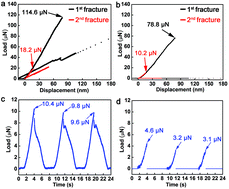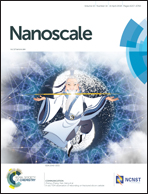In situ TEM observation of rebonding on fractured silicon carbide†
Abstract
Silicon carbide (SiC) is widely used in harsh environments and under extreme conditions, including at high-power, high-temperature, high-current, high-voltage and high-frequency. The rebonding and self-matching of stack faults (SFs) is highly desirable to avoid catastrophic failure for SiC devices, especially for specific applications in the aerospace and nuclear power industries. In this study, a novel approach was developed using an eyebrow hair to pick up and transfer nanowires (NWs), in order to obtain in situ transmission electron microscope (TEM) images of the rebonding and self-matching of SFs at atomic resolution. During rebonding and healing, the electron beam was shut off. Rebonding on the fractured surfaces of monocrystalline and amorphous SiC NWs was observed by in situ TEM at room temperature. The fracture strength was 1.7 GPa after crack-healing, restoring 12.9% of that of a single crystal NW. Partial recrystallization along the <111> orientation and the self-matching of SFs are responsible for the rebonding of the monocrystalline NW. In comparison, the fracture strengths were 6.7 and 5.5 GPa for the first and second rebonding, respectively recovering 67% and 55% of that of an amorphous NW. Atomic diffusion contributed enormously to the rebonding on fractured surfaces of an amorphous NW, resulting in a healed surface consisting of an amorphous phase and crystallites. This rebonding function provides new insight into the fabrication of high-performance SiC devices for the aerospace, optoelectronic and semiconductor industries.



 Please wait while we load your content...
Please wait while we load your content...